Yokosuka P1Y
| P1Y Ginga | |
|---|---|
| | |
| Role | Bomber |
| National origin | Japan |
| Manufacturer | Yokosuka (3 × prototype only) Nakajima Kawanishi (P1Y2 series only) |
| First flight | August 1943 |
| Introduction | October 1944[1] |
| Retired | 1945 |
| Primary user | Imperial Japanese Navy Air Service |
| Number built | 1,102 |
|
| |
The Yokosuka P1Y Ginga (銀河, "Galaxy") was a twin-engine, land-based bomber developed for the Japanese Imperial Navy in World War II. It was the successor to the Mitsubishi G4M and given the Allied reporting name "Frances".
Design and development
The P1Y was designed by the Yokosuka Naval Air Technical Arsenal to Navy specification 15-Shi,[2] calling for a fast bomber with speed matching the Zero, range matching the G4M, a 907 kg (2,000 lb) bombload, and the ability to dive-bomb as well as carry torpedoes. As the result, the construction suffered from excess complexity, difficulty of manufacture, and poor serviceability. Problems with the availability of enough reliable Nakajima Homare engines led to their replacement by the Mitsubishi Kasei in the P1Y2-S night-fighter version.
The streamlined design of the Ginga is attributed to Miki Tadanao, an engineer who, after World War II, went on to create a similar aerodynamic design for Japan's earliest `bullet trains` (Shinkansen), while working with the Japan National Railways (JNR).[3]
Operational history
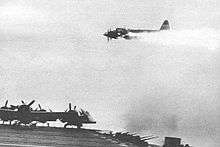
The first flight was in August 1943. Nakajima manufactured 1,002 examples, which were operated by five Kōkūtai (Air Groups), and acted as land-based medium and torpedo bombers from airfields in China, Taiwan, Marianas, Philippines, Ryukyu, Shikoku, and Kyūshū. During the last stages of the war the P1Y was utilized as a kamikaze aircraft against the United States Navy during the Okinawa Campaign in Operation Tan No. 2.
A night fighter version, the P1Y2-S Kyokko (極光, "Aurora"), with Mitsubishi Kasei engines, was equipped with radar and Schräge Musik-style upward-firing as well as forward-firing 20 mm cannon. A total of 96 were produced by Kawanishi,[5] but due to inadequate high-altitude performance against B-29s, many were converted back to Ginga bombers.[6]
Survivors
A P1Y1 survives at the Paul Garber Facility of the National Air and Space Museum. While the fuselage has only been photographed several times and can be found on the internet, the wings and engines of many artifacts are stored in a separate area and they most likely still exist. This was one of three P1Y's that were brought back to the United States after World War II for evaluation.
Variants

- P1Y1 Experimental Type 15 land-based bomber (15試陸上爆撃機, 15-Shi Rikujō Bakugekiki)
- 3 of prototypes and 9 of supplementary prototypes[9] with 1,357 kW (1,820 hp) NK9C Nakajima NK9B Homare 11 engines. Prototype #3 was later used for Ishikawajima Tsu-11 testbed.
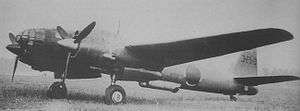
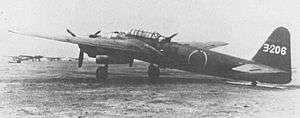

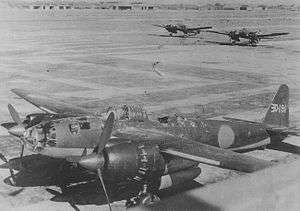
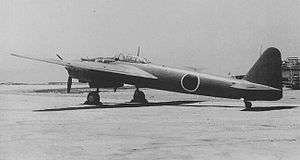
- P1Y1 Ginga ("Milky Way") Model 11 (銀河11型, Ginga 11-gata)
- First model of the series. Mounted Homare 11 or Homare 12.
- P1Y1a Ginga Model 11A (銀河11甲型, Ginga 11 Kō-gata)
- Mounted Homare 12, and fitted 1 × 13 mm (.51 in) Type 2 machine gun in the back defensive position.
- P1Y1b Provisional name Ginga Model 11B (仮称銀河11乙型, Kashō Ginga 11 Otsu-gata)
- Converted from P1Y1a, mounted Homare 12, and fitted 2 × 13 mm (.51 in) Type 2 machine guns in the back defensive position.
- P1Y1c Provisional name Ginga Model 11C (仮称銀河11丙型, Kashō Ginga 11 Hei-gata)
- Converted from P1Y1b, mounted Homare 12, and fitted 1 × 13 mm (.51 in) Type 2 machine gun in the forward position, prototype only.
- P1Y1 Ginga Model 11 Night-fighter variant (銀河11型改造夜戦, Ginga 11-gata Kaizō yasen)
- Converted from P1Y1. Armed with 2 × 20 mm Type 99 cannons. Equipped 302nd Kōkūtai only. This is not a naval regulation equipment.
- P1Y1-S Provisional name Ginga Model 21 (仮称銀河21型, Kashō Ginga 21-gata)
- Night fighter variant. Armed with 4 × 20 mm Type 99 cannons firing obliquely forward, and 1 × 13 mm (.51 in) Type 2 machine gun in the back defensive position. Only a project.
- P1Y1 Ground attack variant
- Converted from P1Y1/P1Y1a, installed up to 20 × 20 mm Type 99 cannons in the bomb bay for land strikes against B-29 bases in the Marianas. Approx. 30 rebuilt.
- P1Y2-S Provisional name Ginga Model 26/Test production Kyokkō ("Aurora") (仮称銀河26型/試製極光, Kashō Ginga 26-gata/Shisei Kyokkō)
- Night fighter variant. Initial named Hakkō ("Corona", 白光) in October 1943, renamed Kyokkō in March 1944.[10] Converted from P1Y1/P1Y1a. Fitted Mitsubishi MK4T-A Kasei 25 engines. Armed with 2 × 20 mm Type 99 cannons and 1 × 30 mm Type 5 cannon. Later, almost all were converted to P1Y2. 96 or 97 produced.[11]
- P1Y2 Provisional name Ginga Model 16 (仮称銀河16型, Kashō Ginga 16-gata)
- Land based bomber. Converted from P1Y2-S. Mounted 1,380 kW (1,850 hp) Mitsubishi MK4T-A Kasei 25 Kō engines.
- P1Y2a Provisional name Ginga Model 16A (仮称銀河16甲型, Kashō Ginga 16 Kō-gata)
- Converted from P1Y1a. Mounted Mitsubishi MK4T-A Kasei 25 Kō engines.
- P1Y2b Provisional name Ginga Model 16B (仮称銀河16乙型, Kashō Ginga 16 Otsu-gata)
- Converted from P1Y1b. Mounted Mitsubishi MK4T-A Kasei 25 Kō engines.
- P1Y2c Provisional name Ginga Model 16C (仮称銀河16丙型, Kashō Ginga 16 Hei-gata)
- Converted from P1Y1c. Mounted Mitsubishi MK4T-A Kasei 25 Kō engines.
- P1Y2 Ginga Model 16 Night-fighter variant (銀河16型改造夜戦, Ginga 16-gata Kaizō yasen)
- Converted from P1Y2. Armed with 2 × 20 mm Type 99 machine guns or 1 × 30 mm Type 5 cannon. Equipped 302nd Kōkūtai only. This is not a naval regulation equipment.
- P1Y3 Provisional name Ginga Model 13 (仮称銀河13型, Kashō Ginga 13-gata)
- Converted from P1Y1. Mounted Homare 21 engines.
- P1Y4 Provisional name Ginga Model 12 (仮称銀河12型, Kashō Ginga 12-gata)
- Converted from P1Y1. Mounted Homare 23 engines.
- P1Y5 Provisional name Ginga Model 14 (仮称銀河14型, Kashō Ginga 14-gata)
- Converted from P1Y1. Mounted Mitsubishi Ha-43 engines.
- P1Y6 Provisional name Ginga Model 17 (仮称銀河17型, Kashō Ginga 17-gata)
- Converted from P1Y2. Mounted Mitsubishi MK4T-C Kasei 25 Hei engines.
- Provisional name Ginga Model 33 (仮称銀河33型, Kashō Ginga 33-gata)
- Long-range bomber variant. Crew: 4, bombs= up to 3,000 kg. Only a project.
- Test production Tenga (試製天河, Shisei Tenga)
- Proposed jet-powered bomber variant, mounted Ishikawajima Ne-30. Discontinued in 1945.
- MXY10 Yokosuka Navy Bomber Ginga
- Ground decoy non-flying replica of Yokosuka P1Y1.
Number built by Nakajima and Kawanishi
| January | February | March | April | May | June | July | August | September | October | November | December | Sub total | |
| 1943 | 2 | 4 | 4 | 10 | 25 | 45 | |||||||
| 1944 | 11 | 20 | 35 | 46 | 46 | 51 | 47 | 48 | 69 | 75 | 88 | 84 | 620 |
| 1945 | 90 | 52 | 52 | 63 | 64 | 53 | 40 | 20 | 434 | ||||
Operators
- Imperial Japanese Navy Air Service[12][13][14][15]
- 302nd Kōkūtai: Equipped night fighter variant only.
- 521st Kōkūtai
- 522nd Kōkūtai
- 523rd Kōkūtai
- 524th Kōkūtai
- 701st Kōkūtai
- 706th Kōkūtai
- 752nd Kōkūtai
- 761st Kōkūtai
- 762nd Kōkūtai
- 763rd Kōkūtai
- 765th Kōkūtai
- 1001st Kōkūtai
- 1081st Kōkūtai
- Miyazaki Kōkūtai
- Toyohashi Kōkūtai
- Yokosuka Kōkūtai
- Kogeki 262nd Hikōtai
- Kogeki 401st Hikōtai
- Kogeki 405th Hikōtai
- Kogeki 406th Hikōtai
- Kogeki 501st Hikōtai
- Kogeki 708th Hikōtai
Specifications (P1Y1a)
Data from Japanese Aircraft of the Pacific War[16]
General characteristics
- Crew: 3
- Length: 15.00 m (49 ft 2⅜ in)
- Wingspan: 20.00 m (65 ft 7¼ in)
- Height: 4.30 m (14 ft 1¼ in)
- Wing area: 55 m² (592 ft²)
- Empty weight: 7,265 kg (16,020 lb)
- Loaded weight: 10,500 kg (23,149 lb)
- Max. takeoff weight: 13,500 kg (29,762 lb)
- Powerplant: 2 × Nakajima NK9C Homare 12 18-cylinder radial engines, 1,361 kW (1,825 hp) (take-off) each
Performance
- Maximum speed: 547 km/h (295 knot, 340 mph) at 5,900 m (19,400 ft)
- Cruise speed: 370 km/h (200 knots, 230 mph) at 4,000 m (13,125 ft)
- Range: 5,370 km (2,900 nmi, 3,337 mi)
- Service ceiling: 9,400 m (30,840 ft)
- Wing loading: 191 kg/m² (39.1 lb/ft²)
- Power/mass: 0.20 kW/kg (0.16 hp/lb)
Armament
- Guns:
- 1× flexible, nose-mounted 20 mm Type 99 cannon
- 1× flexible rear-firing 13 mm Type 2 machine gun
- Bombs: up to 1,000 kg (2,205 lb) of bombs or 1× 800 kg (1,800 lb) torpedo
See also
- Related development
- Aircraft of comparable role, configuration and era
- Related lists
References
| Wikimedia Commons has media related to Yokosuka P1Y. |
- Notes
- ↑ Norman Polmar, Thomas B. Allen, World War II: America at war, 1941-1945, Random House, 1991, p. 310.
- ↑ Francillon 1979, p. 462.
- ↑ Hood, Christopher P. (2007). Shinkansen – From Bullet Train to Symbol of Modern Japan. Routledge, London. p. 53. ISBN 978-0-415-32052-8.
- ↑ USS Natoma Bay (CVE-62) Logbook Project
- ↑ Francillon 1979, p. 468.
- ↑ Francillon 1979, p. 465.
- ↑ The Maru Mechanic (1984), pp. 109–110.
- ↑ Famous Airplanes of the World (2000), pp. 29–31.
- ↑ Famous Airplanes of the World (2000), p. 26.
- ↑ Model Art (2001), p. 50–53
- 1 2 Famous Airplanes of the World (2000), p. 31
- ↑ Francillon 1979, p. 467.
- ↑ The Maru Mechanic (1984), p. 110
- ↑ Model Art (1993), p. 135
- ↑ Famous Airplanes of the World (2000), p. 32–38
- ↑ Francillon 1979, pp. 467–468.
- Bibliography
- Francillon, Ph.D., René J. Japanese Aircraft of the Pacific War. London: Putnam 7 Company Ltd., 1970. ISBN 0-370-00033-1 (2nd edition 1979, ISBN 0-370-30251-6).
- The Maru Mechanic No. 46 Ginga and Type 1 Attack Bomber, Ushio Shobō (Japan), May 1984
- Famous Airplanes of the World, Special Edition Vol. 1 Navy Bomber "Ginga" [Frances], Bunrindo (Japan), September 2000
- Model Art No. 406, Special issue Camouflage & Markings of Imperial Japanese Navy Bombers in W.W.II, Model Art Co. Ltd., April 1993
- Model Art No. 595, Special issue Night fighters of the Imperial Japanese Army and Navy, Model Art Co. Ltd., October 2001